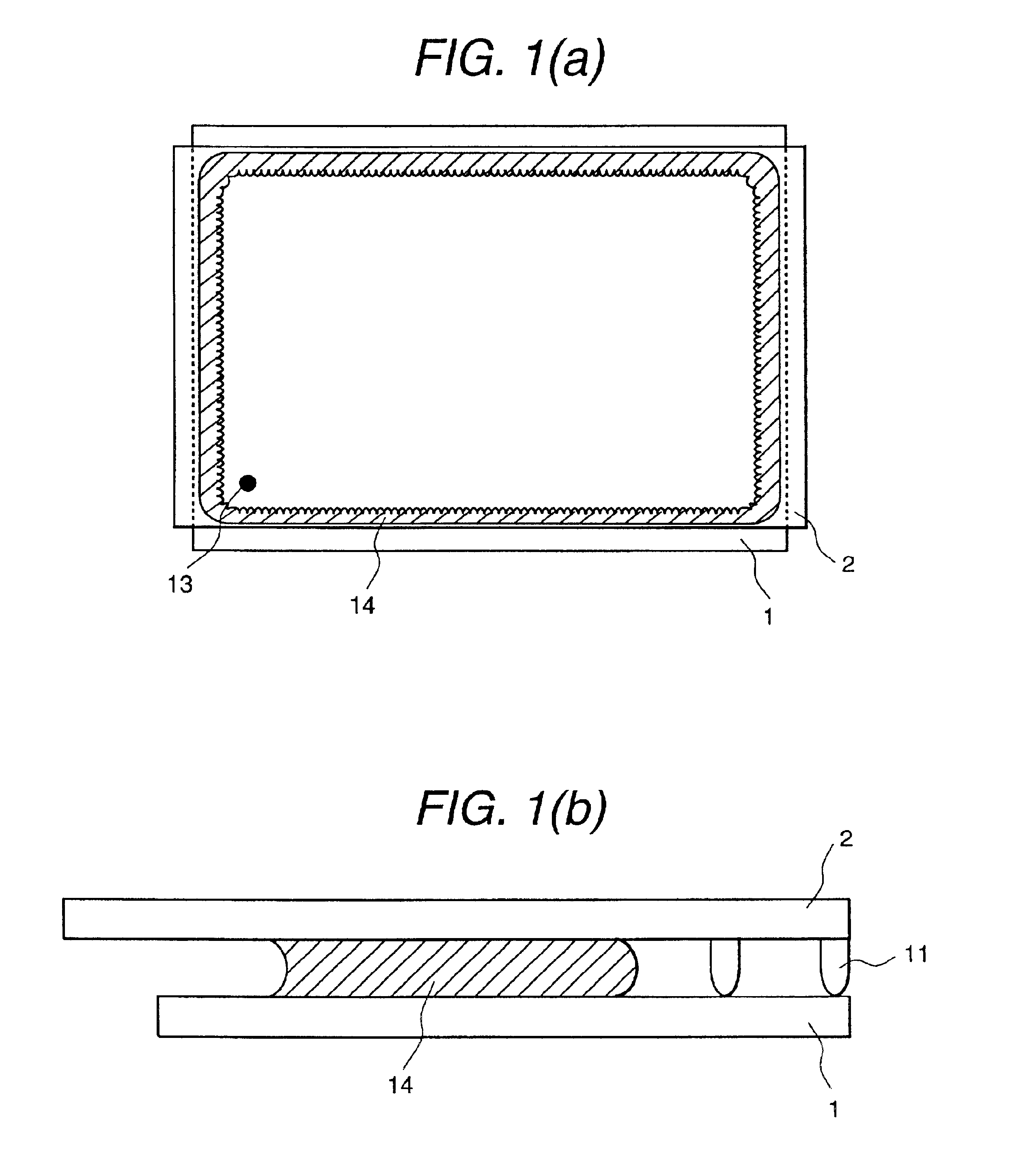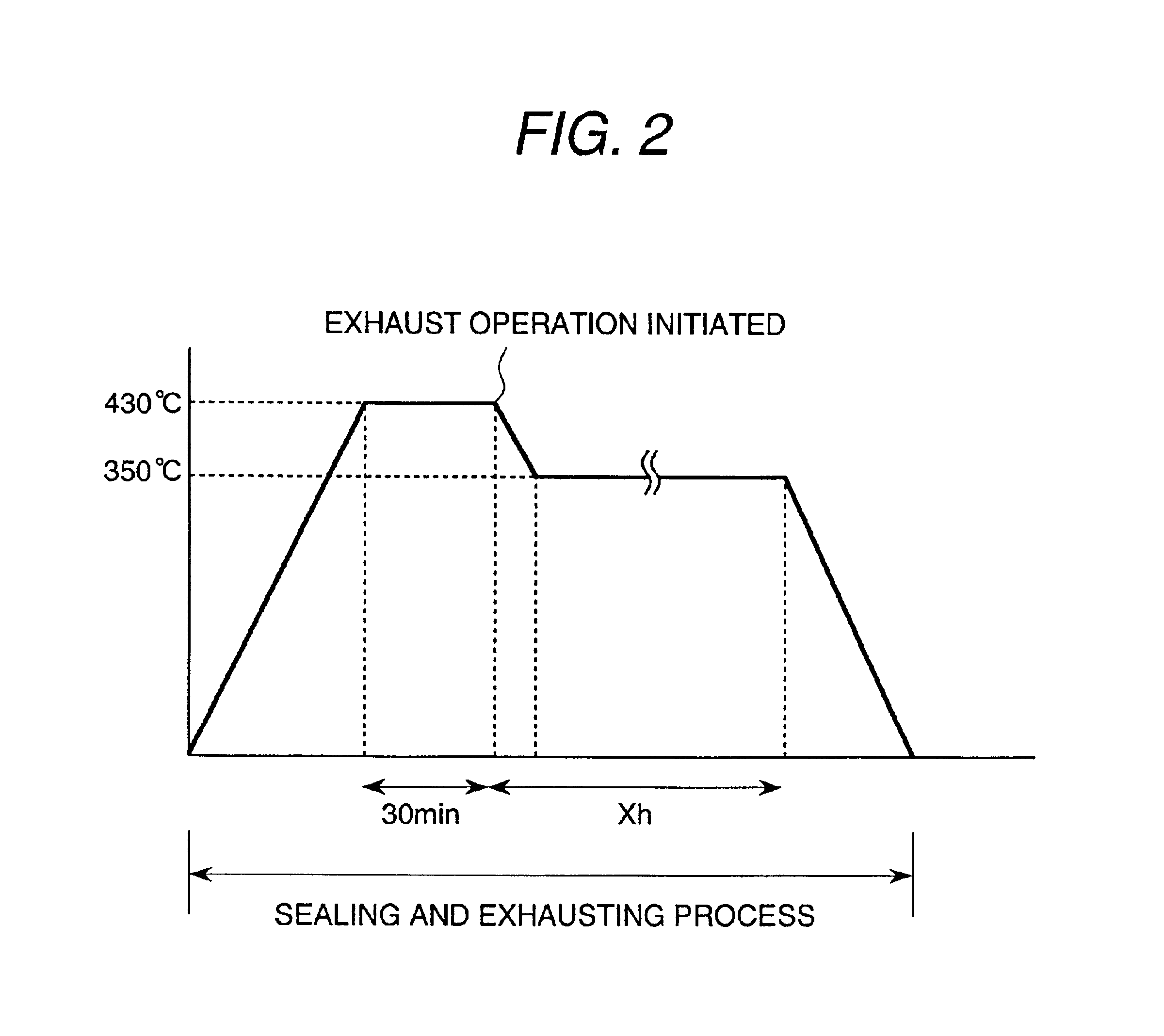Gas discharge type display panel and production method therefor
a technology of display panel and gas discharge, which is applied in the manufacture of electric discharge tubes/lamps, electrode systems, gas exhaustion means, etc., can solve the problems of lowering the brightness of lighting the panel, affecting the quality of the panel, and having a small cross-sectional area, etc., to achieve a higher softening point, and a lower softening point
- Summary
- Abstract
- Description
- Claims
- Application Information
AI Technical Summary
Benefits of technology
Problems solved by technology
Method used
Image
Examples
embodiment 1
(Embodiment 1)
A method of manufacture of plasma display panels representing a first embodiment of the present invention will be described. In this embodiment, a sealing method is used in which the panel is sealed while being subjected to an exhaust operation, and the sealing glass is broken down by using the pressure difference between the inside and outside of the panel. For comparison, a panel manufactured by the conventional sealing method in which the panel is pressurized by clips will be studied as well.
In this embodiment, the pattern for the sealing glass 14 is formed by a dispensing method applied to the back substrate 2, and then, the seal frit is formed by drying and removing the binders. An amorphous glass type seal frit (390° for softening point, 450° for working point and also including the filler materials) is used for the sealing glass 14.
Next, the processes performed after the sealing and exhaust operations will be described. In FIG. 2, a temperature profile for the s...
embodiment 2
(Embodiment 2)
In the second embodiment of the present invention, a plasma display panel is formed by using the different exhaust gas temperature from the first embodiment. FIGS. 8(a) to 8(d) shows the temperature profile for the sealing and exhausting processes.
Another plasma display panel is formed by a procedure which includes initiating the exhausting operation after holding the temperature at 430° C. for 30 minutes and then cooling the panel down to room temperature without maintaining the temperature constant while reducing the temperature. The cross section of the resultant plasma display panel as seen in the direction perpendicular to the back side substrate 2 is then observed. FIG. 9 illustrates diagrammatically the state of the sealing glass 14.
For the panel formed at 450° C. among the panels formed by varying the exhaust gas temperature, the viscosity of the sealing glass 14 is reduced too much and a leakage is formed in the glass for sealing the substrate. In case of seal...
embodiment 3
(Embodiment 3)
In the third embodiment of the present invention, a plasma display panel is manufactured by using a crystalline glass frit (with the softening point at 390° C., the crystallization peak temperature at 430° C. and a filler included) for the sealing glass 14 and an amorphous glass frit (with the softening point at 390° C., the working point at 430° C. and a filler included) for the seal frit bonding between the exhaust pipe 13 and the back substrate 2, and by using an exhaust pipe 13 having a sectional form as shown in FIG. 11(a) or FIG. 11(b). This manufacturing method is the same as that of embodiment 1, and it uses two temperature profiles of the type shown in FIG. 2, including the case (a) in which the first heat reserving process continues for 5 minutes and the second heat reserving process continues for 3.5 hours, and the case (b) in which the first heat reserving process continues for 10 minutes and the second heat reserving process continues for 3.5 hours.
The exh...
PUM
 Login to View More
Login to View More Abstract
Description
Claims
Application Information
 Login to View More
Login to View More - R&D
- Intellectual Property
- Life Sciences
- Materials
- Tech Scout
- Unparalleled Data Quality
- Higher Quality Content
- 60% Fewer Hallucinations
Browse by: Latest US Patents, China's latest patents, Technical Efficacy Thesaurus, Application Domain, Technology Topic, Popular Technical Reports.
© 2025 PatSnap. All rights reserved.Legal|Privacy policy|Modern Slavery Act Transparency Statement|Sitemap|About US| Contact US: help@patsnap.com



